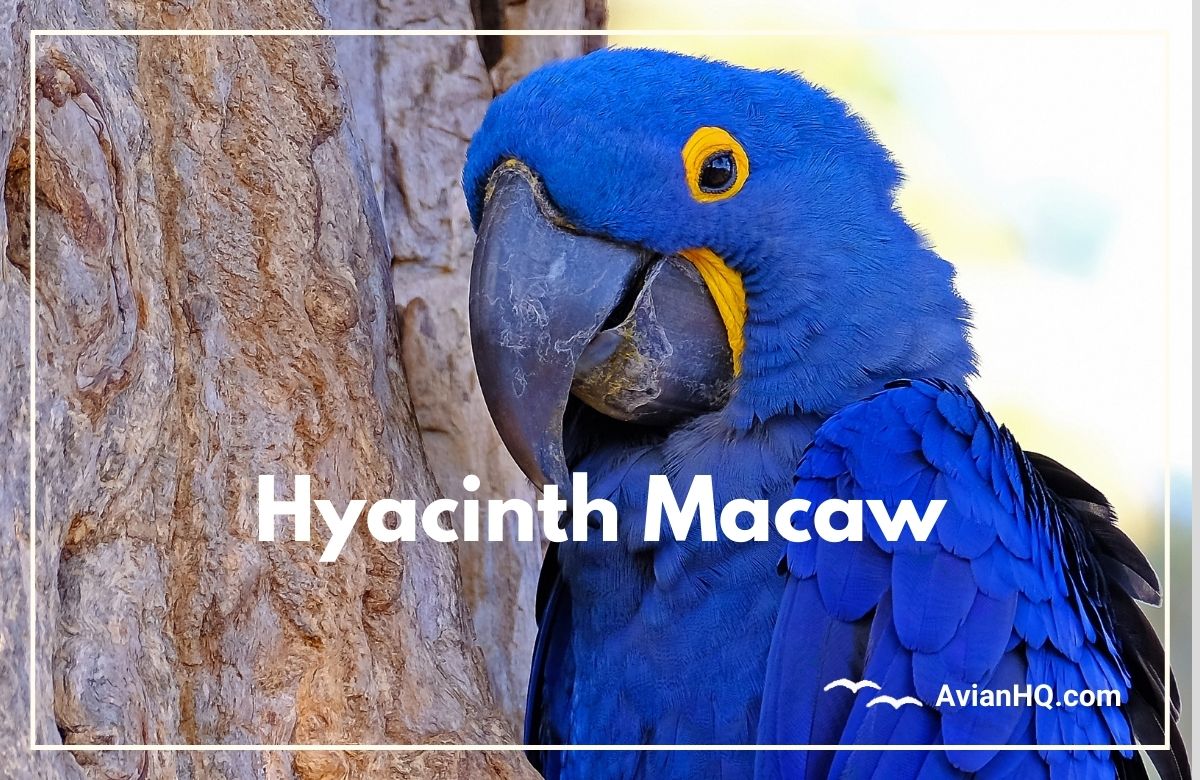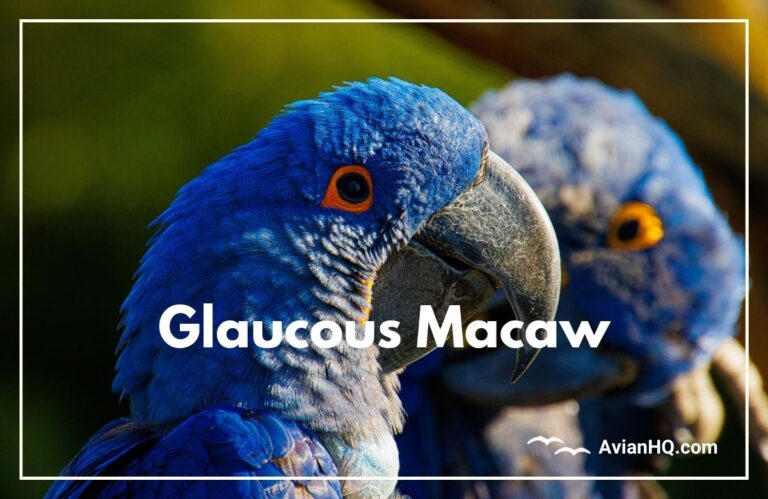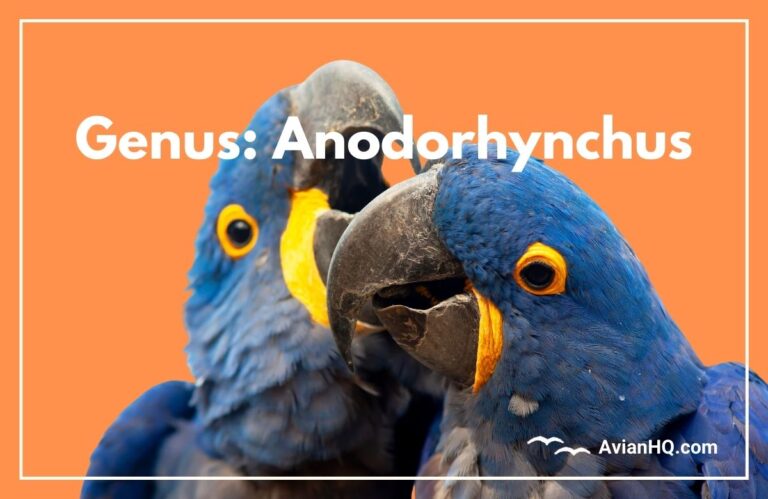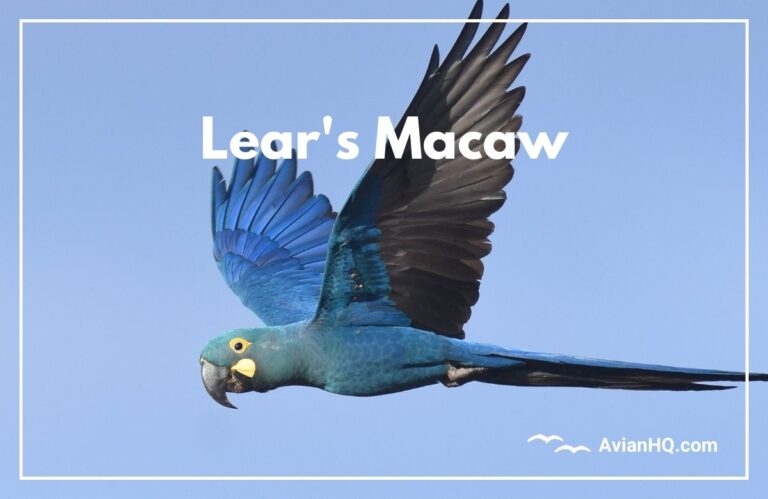Hyacinth Macaw (Anodorhynchus hyacinthinus)
You gaze up at the bright blue parrot with awe. With a length of 100 centimeters (about 3 feet) from the tip of its tail to the top of its head, the Hyacinth Macaw is an impressively large bird. Its bright blue plumage contrasts beautifully with the vibrant yellow skin around its eyes and lower beak. As it opens its mouth to unleash a loud squawk, you get a glimpse of its solid black beak, one of the most powerful in the parrot world.
These magnificent parrots stand out not only for their size and colors, but for their intelligence. They form close social bonds with flock mates and even interact with humans. Yet despite their charisma, Hyacinth Macaws face threats in the wild. Learning more about these birds can help support conservation efforts.
In this article, you’ll discover key facts about Hyacinth Macaws:
- Where they live in South America’s grasslands and forests
- What they eat with their ultra-strong beaks
- How they breed and raise chicks in treetop nests
- Why their conservation status is currently listed as “vulnerable”
Understanding more about this species’ natural history and the threats they face can help support ongoing conservation efforts for their long-term survival. So let’s dive in and explore the world of the magnificent Hyacinth Macaw!
History and Taxonomy
The first known description of the Hyacinth Macaw came from English physician, ornithologist and artist John Latham in 1790. Latham gave the parrot the scientific name Psittacus hyacinthinus in his documentation, classifying it within the wider parrot genus of Psittacus.
Over 200 years later, the Hyacinth Macaw is now classified in its own genus Anodorhynchus, but it retains its specific name hyacinthinus. This binomial scientific name indicates its membership as one of only two existing species within the Anodorhynchus genus, contrasting it from smaller macaws in other genera.
The genus name Anodorhynchus derives from the Greek words “an-” meaning “without,” “dorhy” for “crop” or “gullet,” and “-ynchus” meaning “beak.” This name references the Hyacinth Macaw’s unusually slender gullet compared to most other parrots.
Meanwhile, the species name hyacinthinus refers to the parrot’s vibrant blue plumage, which resembles the color of Hyacinth flowers.
The Hyacinth Macaw has no differentiated subspecies. It is the largest of all parrot species, making it stand out among even its closest macaw relatives. Understanding its scientific classification indicates its uniqueness compared to other parrots around the world.
Scientific name and meaning
The scientific name of the Hyacinth Macaw, Anodorhynchus hyacinthinus, reveals its taxonomic classification. It belongs to the Anodorhynchus genus, which encompasses other species of macaws. The specific epithet “hyacinthinus” refers to the bird’s vibrant blue coloration, resembling the beautiful hyacinth flower.
Physical Appearance
| Physical Features | Description |
|---|---|
| Size | Approximately 100 cm (39 inches) in length |
| Weight | 1.2 to 1.7 kg (2.6 to 3.7 pounds) |
| Plumage colors | Predominantly vibrant blue, ranging from deep cobalt to lighter shades |
| Markings | Feathers have a glossy appearance |
| Bill | Strong, curved, and black |
| Eyes | Yellow |
| Legs/Feet | Dark gray or black |
The Hyacinth Macaw’s most immediate recognizable feature is its bright cobalt blue plumage, which covers most of its body. This vivid blue is interspersed with some darker feathering along its back and wings. The parrot’s tail is long and pointed, reaching a length of 15-17 inches (38.8-42.5 cm).
Hyacinth Macaws have a yellow “ring” of bare skin around their eyes, and also yellow skin on the sides of their lower beak. This yellow facial skin strikes a bold contrast against the macaw’s shiny black beak. Their strong black beak allows them to crack even the hardest palm nuts and seeds.
These parrots are the largest macaw species and the largest flying parrot in the world. From the top of the head to the tip of their long tail, Hyacinth Macaws reach an impressive 40 inches (100 cm) in length. At the same time, they weigh a hefty 2.5-3.5 lbs (1.2-1.7 kg). Their wingspan stretches 3-4 feet (0.9-1.2 m) wide. Needless to say, there is no mistaking a Hyacinth Macaw’s giant size compared to other parrots!
Males and females appear almost identical, without any consistent physical differences between the sexes. Similarly, there are no recognized “subspecies” among these parrots. All Hyacinth Macaws around South America belong to the same genetic population. Their uniform vivid blue plumage holds true across their entire geographic range.
Habitat and Distribution
Hyacinth Macaws naturally live in the grasslands and forests of central and eastern South America. Their range spans Brazil, eastern Bolivia, and northeastern Paraguay.
Within this region, they occupy a variety of habitats including wetlands, palm stands, savannahs, and riverside forests. They thrive in areas with an abundance of native palms that produce their favorite fruit and nut foods.
In Brazil’s Pantanal wetlands, Hyacinth Macaws nest almost exclusively in the holes of tall manduvi trees (Sterculia apetala). They depend on these mature trees, which don’t grow suitable nest holes until they are 60 years old or more.
These birds typically avoid dense rainforests, instead living along forest borders and grasslands with scattered trees. They are most numerous in the Brazilian Pantanal, with an estimated 5,000 birds remaining there. Smaller populations exist in eastern Bolivia and the Gran Chaco region where Paraguay, Brazil, and Bolivia converge.
Sadly the Hyacinth Macaw population has declined in eastern Brazil over past decades due to trapping for the pet trade and habitat loss to agriculture. Conservationists now estimate only 1,000 individuals left in regions that likely hosted more than 10 times that number a century ago.
There is also a small introduced population of escaped Hyacinth Macaws living non-natively in Florida. Though sightings have increased in recent decades, there’s no proof that these escaped pet birds are breeding to sustain a true wild population in Florida long-term.
Diet and Feeding
The Hyacinth Macaw has specialized dietary habits, feeding almost exclusively on the nuts and fruits of particular native palm trees. This makes it completely dependent on the presence of those species to survive.
Their favorite food is the nuts of the acuri and bocaiuva palms found in their Brazilian habitat. The incredibly hard shells of these nuts would be impossible for most birds to open. Luckily, the Hyacinth Macaw possesses one of the most powerful beaks in the parrot family, enabling it to crack even the toughest palm nuts with pressures over 300 pounds per square inch.
These parrots use their strong black beaks as nutcrackers to reveal the fatty, protein-rich nuts inside. The macaws’ bare facial patches also likely help them grip and maneuver the nuts while opening them. They eat both the soft inner nutmeat and the young shoots and fruits surrounding it.
In addition to the palms at the center of their diet, Hyacinth Macaws supplement by eating fruits and seeds of other rainforest trees. Their varied diet provides them with fat, protein and essential nutrients.
You’ll never see Hyacinth Macaws feeding quietly though! They make constant noise while crunching nuts with their beaks or moving around in search of food trees. These feeding behaviors show how their loud calls and squawks help them communicate and locate their brightly colored flock mates amongst the camouflage of leaves and branches.
Breeding and Reproduction
Hyacinth Macaws reach breeding maturity between 5 and 7 years old. They breed at the start of the rainy season, between July and December across their South American habitat.
These large parrots nest in holes found inside tall, mature trees including native palms. They rely on existing hollows created by damage or decay in living trees, as well as holes excavated over decades by other large bird species like woodpeckers and aracaris.
Competition is fierce for the relatively few trees that contain adequately sized hollows. As a result, Hyacinth Macaw pairs aggressively defend their chosen nest tree from rivals. Their holes may be 50-100 ft high up off the ground inside trunks 3 feet or more in diameter.
Once they secure a suitable nesting hollow, the mated pair lays 1-2 eggs inside. The female then incubates the eggs alone for about one month while the male feeds and watches over her.
| Reproductive Aspect | Average Duration |
|---|---|
| Incubation period | 26-28 days |
| Fledging time | Approximately 3 months |
Anywhere from 1-2 chicks (or rarely 3) will hatch after 30 days or a bit less. Covered in yellow downy feathers, the baby macaws develop quickly under their parents’ devoted care. After 3-4 months, they’ll be ready to emerge from the nest, eventually fledging at around 110 days old once their blue adult plumage grows in.
The young Hyacinth Macaws stick close by their parents’ side for an additional 2 months or more after leaving the nest hole. By 6 months of age they become nutritionally independent, but they’ll continue associating with their parents in a familial flock as they further mature.
Behavior and Ecology
Hyacinth Macaws are highly social birds that occur in pairs or small groups called flocks. At times during the day, several pairs or family units may congregate in the same feeding or roosting areas. But most forage primarily in the close company of their bonded mate.
These vocal parrots keep up frequent loud squawking and calling to maintain contact with their flockmates. Their raucous cries of “kronk-kronk” resound over long distances as they fly between palms searching for ripening nuts.
Hyacinth Macaws communicate information to coordinate movements and warn each other using a diversity of loud vocalizations and cues from their bright plumage. Pairs preen each other’s feathers frequently as part of bonding behavior. They defend feeding territories all year, but allow some overlap with other macaws.
Roosting patterns vary based on food availability and seasonality. During dry periods, birds congregate at still fruiting or nut-bearing trees. In wet seasons when more food trees occur dispersed widely, the macaws spread out in smaller groups across the landscape.
Long term studies show Hyacinth Macaws rely heavily on South America’s Toco Toucan for seed dispersal and nesting availability. Yet they also lose over half their eggs and chicks to toucan predation each year. This complex balance shows the interdependence of plant and animal species in ecosystems the Hyacinth Macaw inhabits.
Conservation Status
Due to significant population declines over the last several decades, the Hyacinth Macaw is classified as “Vulnerable” on the IUCN Red List of Threatened Species. Though no precise surveys exist, best estimates suggest from 3,000-5,000 total individuals remaining in the wild.
The two greatest threats causing dramatic drops in their numbers are:
- Illegal trapping for the pet trade
- Habitat loss
Hyacinth Macaws are highly prized for their beauty, size, and rarity. Poachers take chicks from wild nests and smuggle the birds out of Brazil and Bolivia to sell within the profitable illegal pet trade. Trapping levels accelerated in the 1980s and have left the species depleted despite now being protected from legal capture and export. Efforts to crack down on smugglers continue.
At the same time, cattle ranching and agriculture expanding in South America have destroyed vast areas of natural habitat required by Hyacinth Macaws. The development of dams and drainage projects has further eliminated critical wetland and palm grove ecosystems. Their specialized habitat niche makes Hyacinth Macaws far more vulnerable to these threats than most other parrot species sharing their range.
Given estimates of a possible 90% population decline since the early 1900s, conservationists still consider Hyacinth Macaws at significant risk without improved enforcement. However, they have achieved stability or slight increases in number within intensively managed reserves like Brazil’s Pantanal National Park over recent years. Ecotourism may offer hope, making the spectacular macaws more valuable to locals alive for visitors to see than captured for illegal trade.
Cultural Significance
The majestic Hyacinth Macaw holds a place of significance in both indigenous and modern culture across its South American habitat.
Historically, native peoples including the Kayapo tribe prized Hyacinth Macaws for their bright blue feathers. Kayapo warriors traditionally wore headdresses decorated with Hyacinth Macaw plumes as a symbol of courage and status. Sadly such use accelerated unsustainable hunting that exacerbated the species’ decline.
Today the parrot’s breathtaking colors and charisma still make it an iconic bird encapsulating the biodiversity of Brazil’s Pantanal wetlands region. As Hyacinth Macaws have gained international attention through ecotourism and conservation initiatives, they have become flagship mascots for wildlife preservation across South America’s grasslands and forests.
Internationally, Hyacinth Macaws are highly coveted – though demanding – pets. Aviculturalists admire their beauty and longevity, as captive macaws may live 50 years or more. However handling their specialized needs as large, loud, active birds in a domestic environment often proves challenging.
Where wild populations stabilize in protected havens like Brazil’s Pantanal National Park, responsible ecotourism allows visitors glimpses of Hyacinth Macaws within their natural habitat. Such tourism both inspires international support for conservation, as well as makes preservation of these macaws economically rewarding for local communities.
“The Hyacinth Macaw represents the beauty and resilience of our people. Its vibrant blue plumage and majestic presence inspire us to protect our land and preserve our traditions.” – Indigenous Elder
Conclusion
The Hyacinth Macaw stands out as one of the most stunning and largest members of the parrot family worldwide. Its brilliant blue plumage and golden facial accents captivate all who glimpse these birds in flight. Yet for all their physical majesty, Hyacinth Macaws now face an uncertain future.
From an estimated historical population in the tens of thousands, habitat destruction and poaching over the past century have decimated numbers to around 3,000-6,000 remaining in South America’s grasslands and palm groves. Their specialized reliance on particular native palms makes these macaws especially vulnerable.
However, intensive conservation efforts focused on protected reserves aim to save the Hyacinth Macaw from extinction. Ecotourism may offer hope by making Hyacinth Macaws more economically valuable alive in Brazil and Bolivia’s wilds than sold on the black market pet trade.
Understanding more about Hyacinth Macaws – from their vital ecological relationships to modern-day threats – allows us to better support ongoing preservation efforts. With sustained habitat conservation and anti-poaching measures, hopefully future generations will still experience the wonder of these regal blue macaws shrieking over South American skies.




